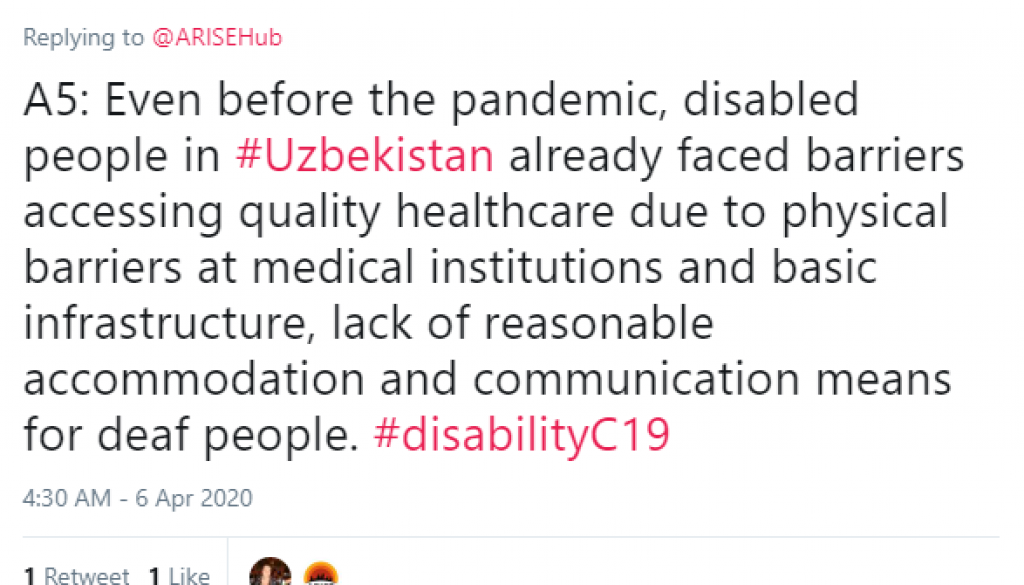Barriers to health care related to disability and COVID-19
People with disabilities frequently face barriers that prevent them accessing health care and treatment. These barriers can be both structural and attitudinal. In times of crisis it can become even more difficult to access care due to lack of accommodations and disruption of routine health service provision.
@gordonrattray from @EDF shared with us that PWD are excluded from society on a daily basis bcoz of physical, communication, attitudinal and institutional barriers. Worse in humanitarian emergencies. It’s not #disabilityC19 that makes people vulnerable, it’s barriers in society
— Laura Dean (@Laura_Deano) April 6, 2020
In the second blog of a series that summarises learning from our Twitter Chat on Disability and COVID-19 we discuss barriers to health care. Participants in the Chat emphasised that there are multiple barriers to routine treatment and care which are frequently experienced by people with disabilities. In times of crisis these barriers are often made worse.
As services considered less essential are shut down to release health care workers to support the response to COVID-19 we may see a reduction in rehabilitation services, hampering recovery. There was also concern about the availability of medicines, for example anti-convulsants, if the health system is severely compromised.
Restrictive policy measures such as lockdowns and curfews may interrupt home care services and the flow of other essentials such as food into the households of disabled people. It may lead to police brutality against people with disabilities who leave the home to survive.
A2: #COVID19 related quarantines/restrictive prog. may result in disruption of services vital for people with disabilities incl. food, health care, wash and sanitation, communications, hence undermining their rights and capacity to cope with the crisis #DisabilityC19 @COREGroupDC
— IDDC (@iddcconsortium) April 6, 2020
People with disabilities face an ongoing struggle in realising their right to health. This is influenced by their gender, geography, social location, societal priorities and attitudes which intersect with disability type to create inequities in health service access. This is not new but is highlighted during a crisis like COVID-19.
A5: A reduction in transport and social care services, prioritisation of health services and huge demand on delivery services could build further barriers and widen gaps to care. #DisabilityC19
— DisabilityInnovation (@GDIHub) April 6, 2020
Structural barriers include: inaccessible communication (for example, lack of sign language, braille, pictorials or simple language); health facilities that are difficult to access because they are far away or there are bad roads and poor transport infrastructure; and financial barriers because of treatment costs and limited money to pay for health services or transport.
A5: Lack of livelihood opportunities (only 2% are employed), small disability benefits (50$ per month) do not allow them to access quality healthcare. Although the Uzbek government says the primary healthcare is free you need money to access health services. #disabilityC19
— Dilmurad Yusupov (@d_yusupov) April 6, 2020
Attitudinal barriers, particularly of health providers are also a problem. As @WurieHaja explained, ‘in some contexts, the disabled are seen, but not seen’.
The Covid-19 pandemic could be an opportunity to raise the importance of addressing challenges and barriers lived daily by people with disabilities, a mechanism to communicate and demonstrate challenges to people in power.
A5. Multiple barriers for #ME: inadequate #MedEd, inadequate investment in biomed research, harmful guidelines, oppression of invalidation, compounded by patriarchy. Could #covid19 mark a turning point as people in power get a glimpse of our worlds? #disabilityC19 @chronicinclude
— Dr Anna Ruddock (@annalouruddock) April 6, 2020
<<Find out more about this series of blogs on disability and COVID-19
[embedyt] https://www.youtube.com/watch?v=ekylIqKgl-Q[/embedyt]

Disability and COVID-19: What did we learn from the Twitter Chat - Arise
15/04/2020 @ 17:01
[…] Barriers to health care related to disability and COVID-19 […]